The new M1 MacBook Pro and MacBook Air are outstanding. Their performance almost lives up to Apple's extraordinary claims, their look and feel is reassuringly Apple-grade, their battery life is, simply put, exemplary, and the transition from x86 to ARM, so far at least, has gone shockingly smoothly. "Those don't really sound like problems" you might say. And they're not. For you. You gotta pay attention. I said Apple has a problem, 'cause it's gonna be really hard to one-up what they've done here.
When Apple unveiled their first ARM-equipped MacBooks, we were surprised by the port selection, to say the least.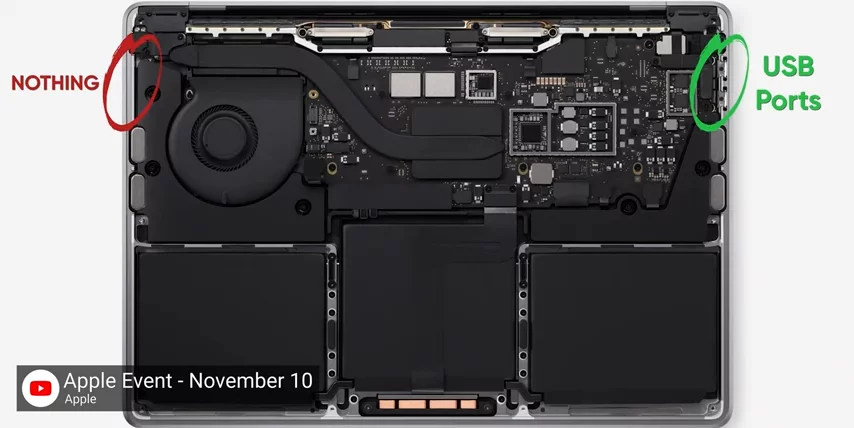 Just two USB-C's might be nothing new for the MacBook Air, but there's no high-end option available for the Pro, which until now had options for four.
Just two USB-C's might be nothing new for the MacBook Air, but there's no high-end option available for the Pro, which until now had options for four.
This appears to be due to the M1 SoC's limited I/O capabilities, which also explains why you're limited to a single external display unless you turn to display link adapters. That may not be a deal breaker for these classes of machines, but it's worth mentioning regardless. What's interesting, though, is that, while we did determine in our Mac mini review that you cannot expand that device using an external graphics card, we followed up our testing with a 10-gig network card, and found that when we ran that in our Razer Core X, the Thunderbolt-like external PCI Express functionality was working just fine. So it's definitely down to just a GPU compatibility thing.
The Magic Keyboard style switches remain far superior to the fatally flawed butterfly switches that were found on all but the most recent Intel MacBooks since 2016, and both the Air and the Pro are an absolute delight to type on and offer quick biometric authentication through the Touch ID sensor in the power button. The only difference in the keyboard is the Touch Bar.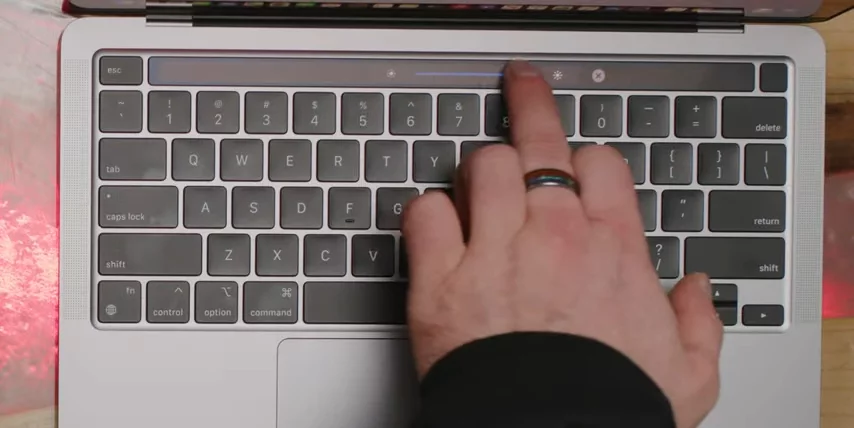 Love it or hate it, you're not getting one if you buy an M1 Air, and you are definitely getting one if you pony up the extra $300 for the Pro. And that difference in price is a pretty tough pill to swallow when you consider how close these machines appear on paper other than the Touch Bar.
Love it or hate it, you're not getting one if you buy an M1 Air, and you are definitely getting one if you pony up the extra $300 for the Pro. And that difference in price is a pretty tough pill to swallow when you consider how close these machines appear on paper other than the Touch Bar.
But the keyword is, of course, close. There are some differences. Aside from its lack of active cooling, the baseline MacBook Air only has seven GPU cores, with the upgraded eight-core version like ours costing an extra 50 bucks if you factor in the cost of the bigger SSD that it also includes. That kinda makes it a "sure, why not" upgrade if you've got any desire for 512 gigs or more storage. But if not, you're just gonna have to swallow it anyway if you need the extra GPU power that you can otherwise only get with the Pro. And this inflexibility in configurations is one of the prices that we pay for the tight integration of Apple's M1 SoC. Same goes for memory. It starts at eight gigs, and only goes up to 16 gigs for either of these machines, presumably because adding more DRAM packages to the current M1 would increase cost or power consumption by too much for this class of product. They do have a history of worrying about such things, after all. And besides, if the performance we saw in our M1 Mac mini review is anything to go by, that trade-off is one that has paid great dividends.
But that's on the desktop. What we haven't seen yet for ourselves is how it performs against competing mobile products, like Intel's Tiger Lake and AMD's Renoir APUs. Dell and HP are gonna be representing the PC competition. 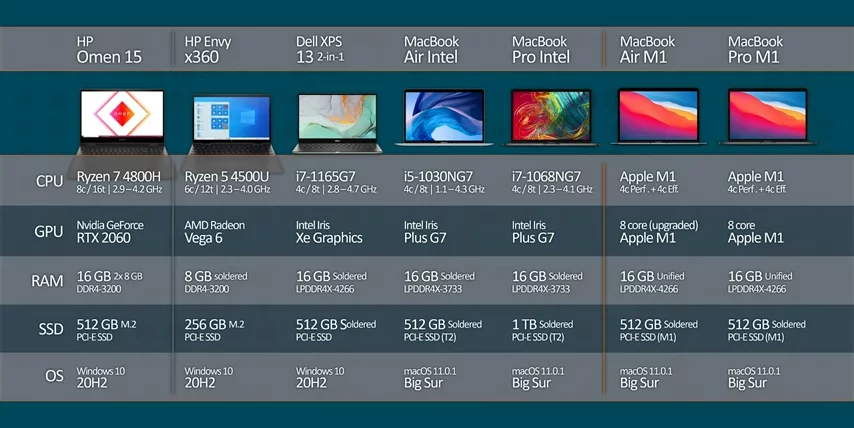 And we also threw a 15-inch HP OMEN gaming laptop in there in case the M1 gets too fast to compare to anything in its weight class.
And we also threw a 15-inch HP OMEN gaming laptop in there in case the M1 gets too fast to compare to anything in its weight class.
In Cinebench R23, the only laptop in this lineup capable of beating either MacBook is a much thicker gaming machine,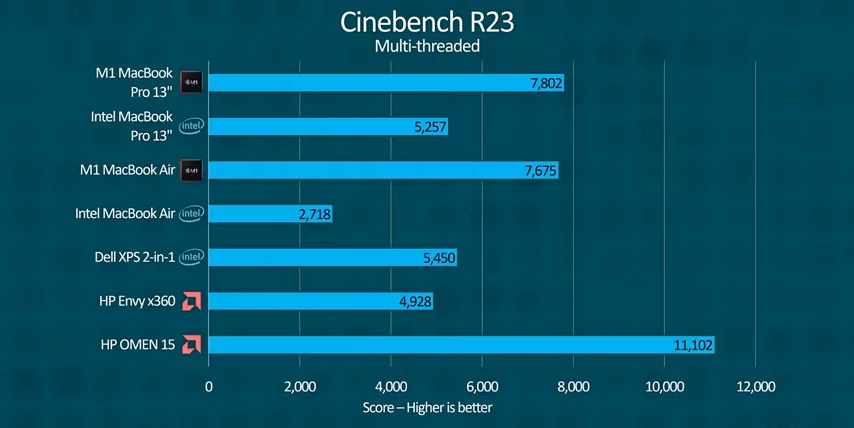 and even it doesn't win the single-threaded performance crown.
and even it doesn't win the single-threaded performance crown. 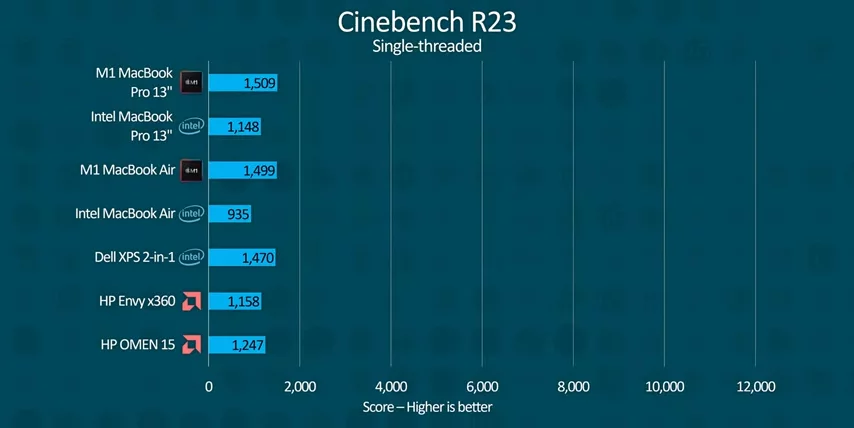 Even more impressively, after a 10-minute run, the MacBook Pro's performance remained rock solid,
Even more impressively, after a 10-minute run, the MacBook Pro's performance remained rock solid, 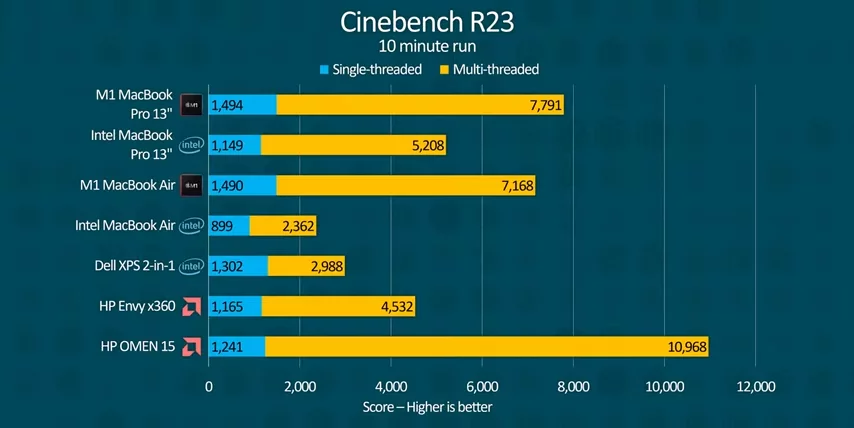 while the HP OMEN, with its much beefier cooling working noticeably harder, dropped over 100 points. Unlike its bigger cousin, the MacBook Air did throttle, but it still managed to stay well clear of anything else in its weight class.
while the HP OMEN, with its much beefier cooling working noticeably harder, dropped over 100 points. Unlike its bigger cousin, the MacBook Air did throttle, but it still managed to stay well clear of anything else in its weight class.
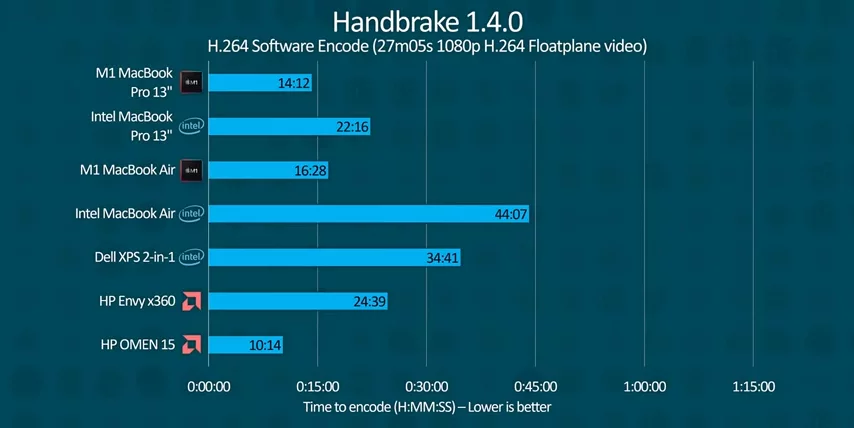 Handbrake again shows our M1 Macs outperforming their x86 counterparts by nearly double in software encoding.
Handbrake again shows our M1 Macs outperforming their x86 counterparts by nearly double in software encoding. 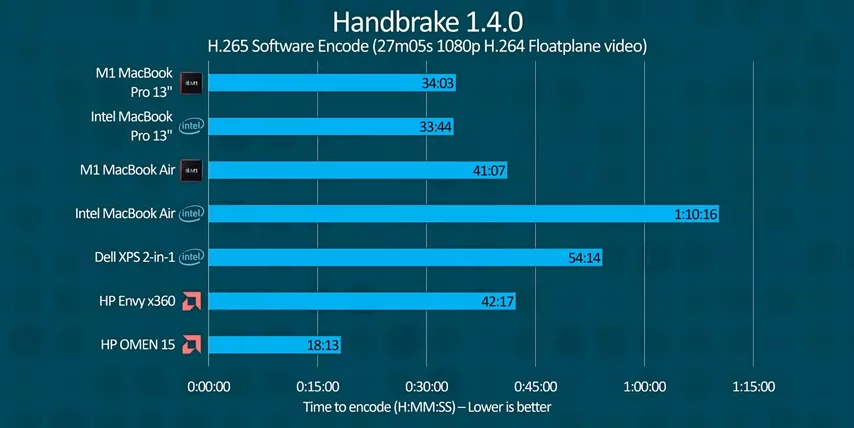 Seriously, guys, it's not even close. The 2020 Intel MacBook Air took three times as long.
Seriously, guys, it's not even close. The 2020 Intel MacBook Air took three times as long.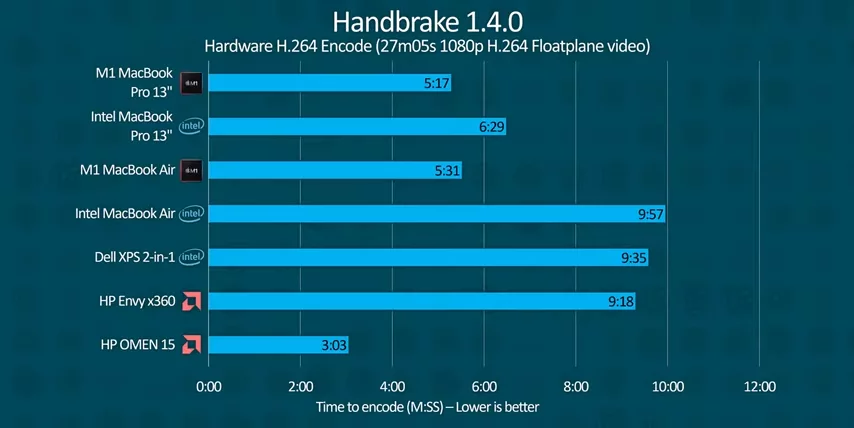 And as for hardware encoding, again, we see the M1 encoding blocks doing their job and then some,
And as for hardware encoding, again, we see the M1 encoding blocks doing their job and then some, 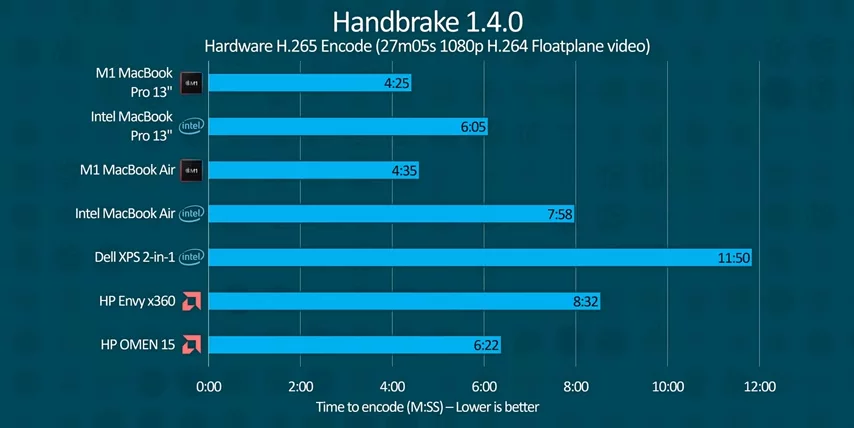 beating out both Intel and AMD's encoder engines by 50 to 100%, and, this was surprising, even beating out NVENC in H265.
beating out both Intel and AMD's encoder engines by 50 to 100%, and, this was surprising, even beating out NVENC in H265. 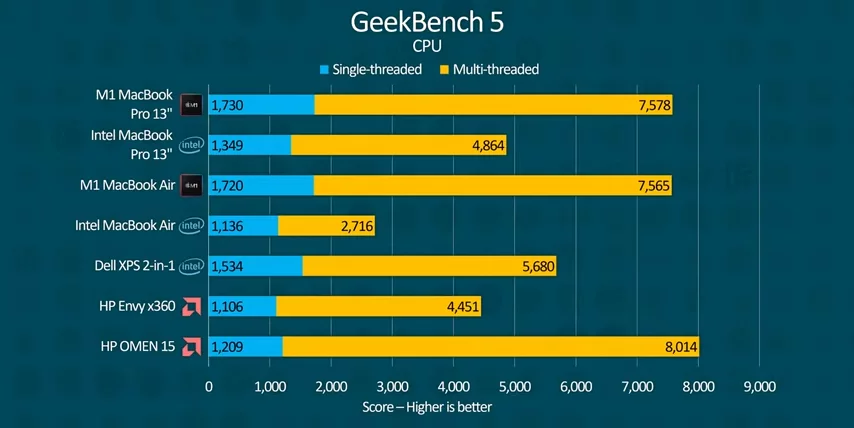 For giggles, we ran GeekBench, since that's what all the cool kids are running, and if it's to be believed, the only CPU with any hope of matching the M1's multi-threaded performance is a Ryzen 7 eight-core. It is a good thing we put the OMEN in there.
For giggles, we ran GeekBench, since that's what all the cool kids are running, and if it's to be believed, the only CPU with any hope of matching the M1's multi-threaded performance is a Ryzen 7 eight-core. It is a good thing we put the OMEN in there.
The GPU, meanwhile, soundly destroys both the AMD and Intel competition, 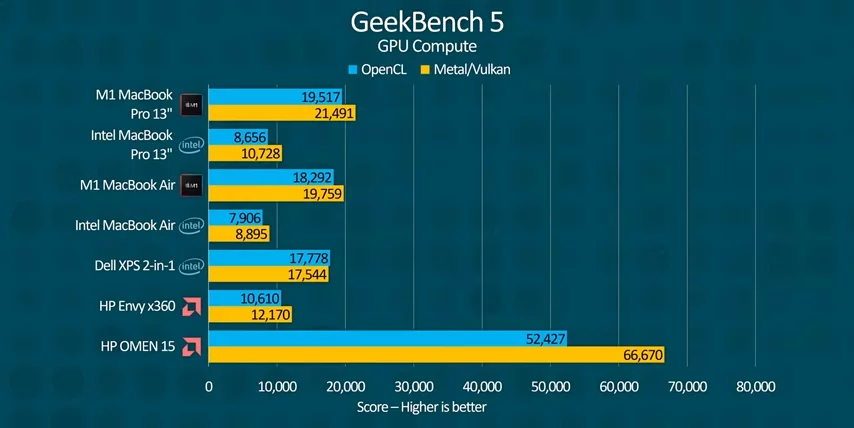 although it should be noted that this isn't a useful real world test.
although it should be noted that this isn't a useful real world test.
Moving on to non-native tests using Rosetta, Adobe Creative Cloud presented a challenge.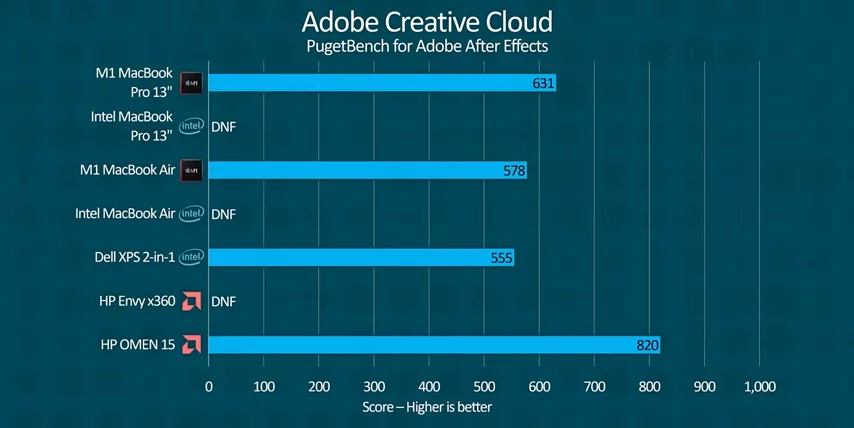 Not only did After Effects fail to run on either of our Intel Macs, it and Premiere Pro also failed to run on our HP Envy due to its mere eight gigs of memory,
Not only did After Effects fail to run on either of our Intel Macs, it and Premiere Pro also failed to run on our HP Envy due to its mere eight gigs of memory, 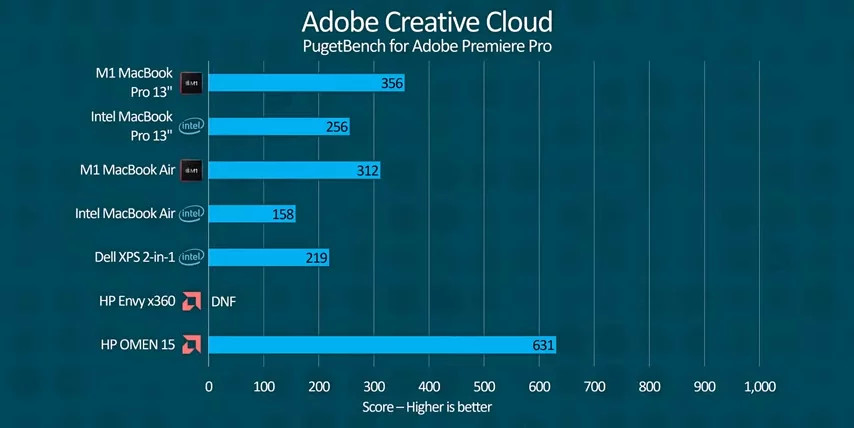 and we suspect that Photoshop performance probably suffered as well.
and we suspect that Photoshop performance probably suffered as well.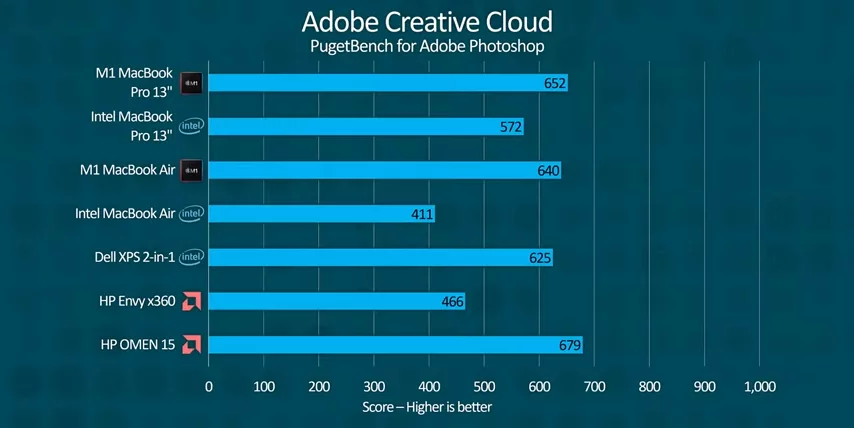 Still, though, we were able to at least observe that even running in Rosetta, remember, this is non-native code, the M1 MacBooks both managed to smoke the competition, and the same holds true for Blender,
Still, though, we were able to at least observe that even running in Rosetta, remember, this is non-native code, the M1 MacBooks both managed to smoke the competition, and the same holds true for Blender,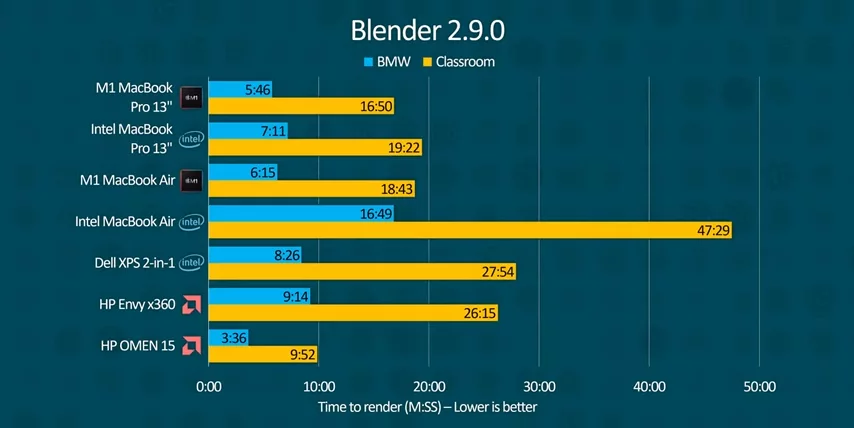 where the M1 MacBook Air manages to triple the speed of its predecessor and run eight to nine minutes faster than its x86 competitors.
where the M1 MacBook Air manages to triple the speed of its predecessor and run eight to nine minutes faster than its x86 competitors.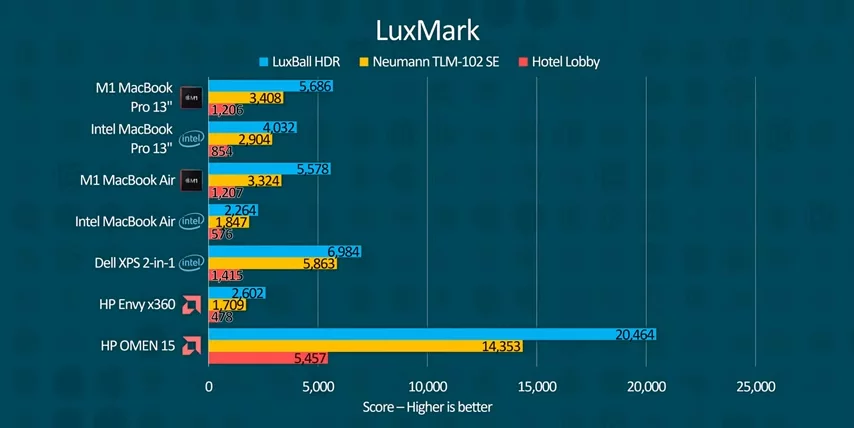 The only potential response to M1, at least in class, is in LuxMark, where the XPS 13's Xe graphics core puts up better numbers across the board, while the others languished at about half of the performance, or even less.
The only potential response to M1, at least in class, is in LuxMark, where the XPS 13's Xe graphics core puts up better numbers across the board, while the others languished at about half of the performance, or even less.
On that subject, I mean, we can't talk about graphics cores without talking about gaming, so of course we ran the Tomb Raiders to see what we could get, and found that our MacBooks managed double or better the frame rates recorded by either the AMD or Intel UHD integrated graphics in our competing products.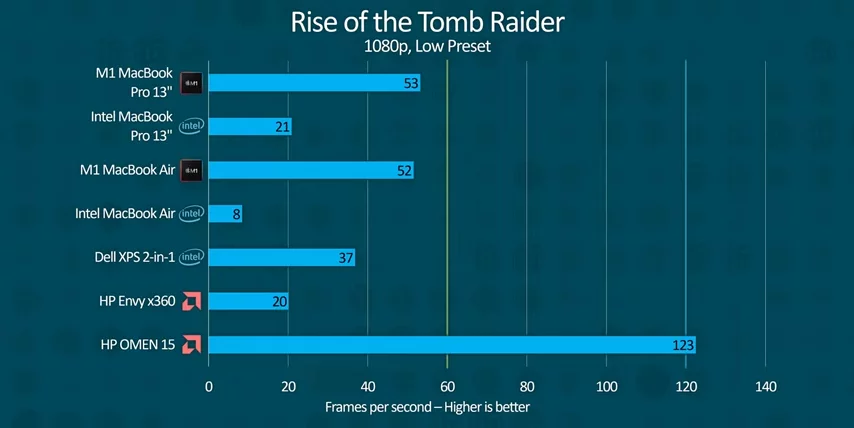 The one exception aside from the dedicated gaming laptop is the Xe-equipped XPS 13, which put up an admirable fight, at least by comparison, but still couldn't really close the gap.
The one exception aside from the dedicated gaming laptop is the Xe-equipped XPS 13, which put up an admirable fight, at least by comparison, but still couldn't really close the gap.
Thanks to a recent update to another great Mac system monitor, 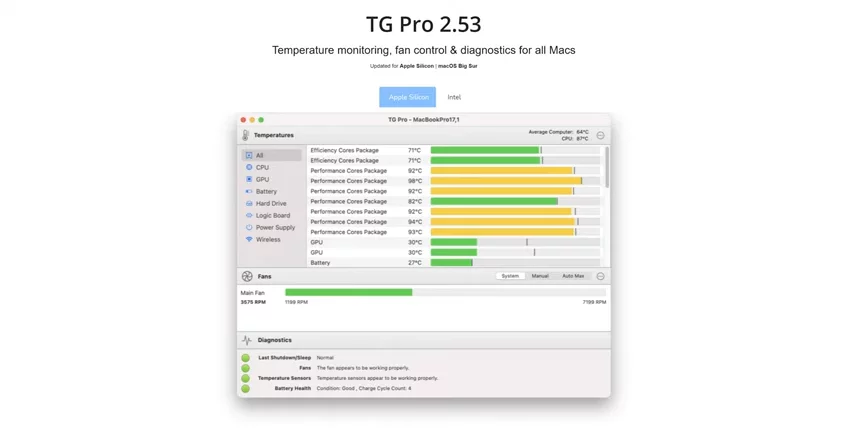 TG Pro, we can glean a little more information about M1's throttling behavior compared to our Mac mini review.
TG Pro, we can glean a little more information about M1's throttling behavior compared to our Mac mini review. 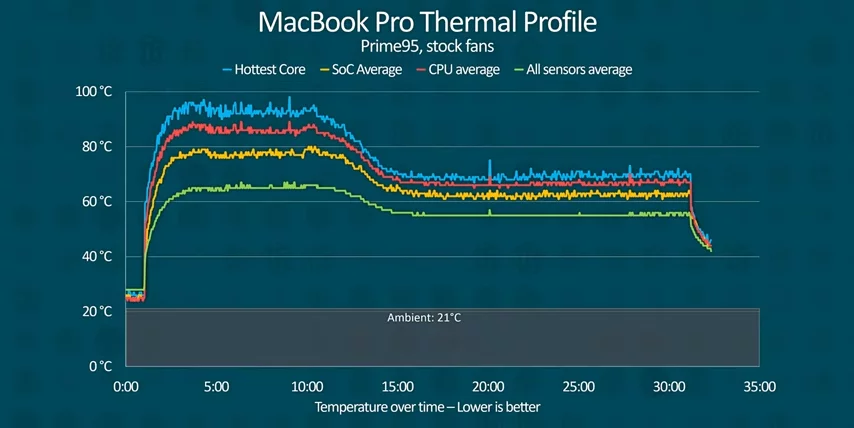 By default, our MacBook Pro at full synthetic load breaches 90 degrees and does throttle, with the fan ramping up to about 3,500 RPM, or roughly half-speed.
By default, our MacBook Pro at full synthetic load breaches 90 degrees and does throttle, with the fan ramping up to about 3,500 RPM, or roughly half-speed.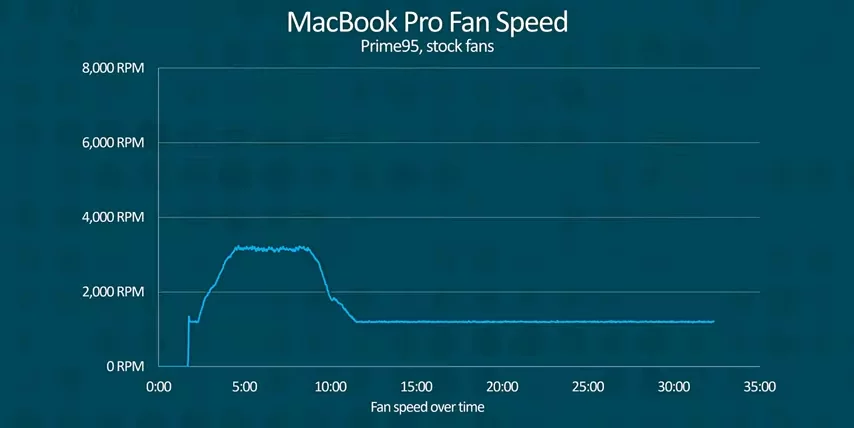
Now, that's still very quiet, and there are two important notes here. One: as we've seen, that throttling clearly didn't have a measurable impact on performance. And two: these core sensors that we're reading are buried inside the multi-layered SoC. So unlike previous generations, these readings act more like hotspot sensors, which from our experience can report 10 to 15 degrees higher than the rest of the chip. So with that in mind, then, we don't foresee any serious reliability problems.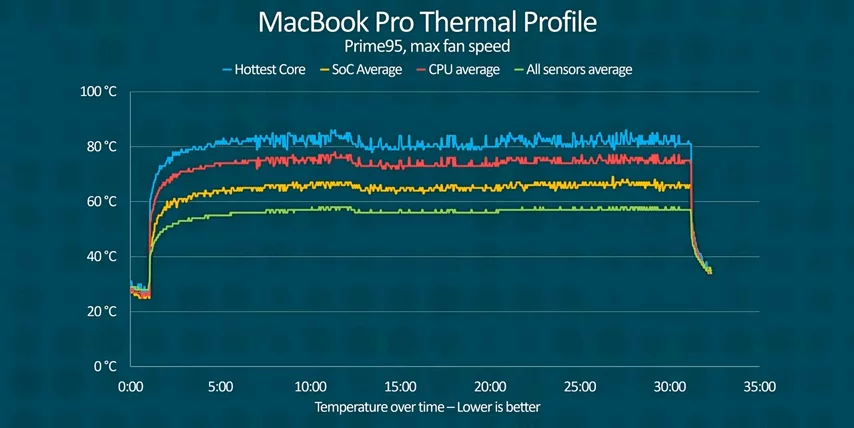 But manually setting the fan to maximum using TG Pro can improve core thermals to between 80 and 85 degrees, which should keep max performance locked and provide peace of mind to enthusiasts who just like low temperatures, even if it's at the expense of having a laptop fan that they can actually hear.
But manually setting the fan to maximum using TG Pro can improve core thermals to between 80 and 85 degrees, which should keep max performance locked and provide peace of mind to enthusiasts who just like low temperatures, even if it's at the expense of having a laptop fan that they can actually hear.
It's really refreshing to see Apple take a more conservative approach to thermals, maybe because now it's their own silicon that they're messing with. The MacBook Air takes a different approach altogether,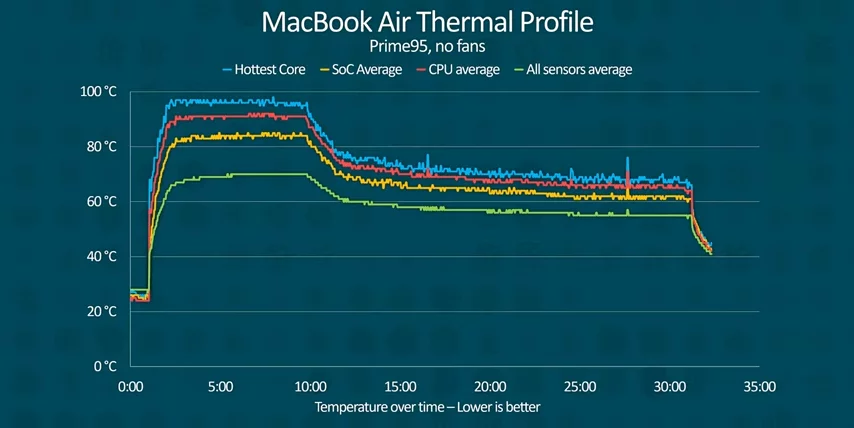 though, again allowing the cores to reach as high as the mid-90 degrees or so, but then after it reaches an average temperature of roughly 70 degrees, it throttles to maintain that, at least for a while. Then, it dials everything back and targets a CPU temperature of 60 degrees. This is why the Air gets such great burst performance, while also maintaining comfortable surface temperature. Of course, it comes at the cost of sustained performance.
though, again allowing the cores to reach as high as the mid-90 degrees or so, but then after it reaches an average temperature of roughly 70 degrees, it throttles to maintain that, at least for a while. Then, it dials everything back and targets a CPU temperature of 60 degrees. This is why the Air gets such great burst performance, while also maintaining comfortable surface temperature. Of course, it comes at the cost of sustained performance.
Since we can't just ramp up the fans on the Air to see if that changes things, maybe we'll need to take another crack at fixing Apple's thermal design.
The webcam on both new MacBooks is, shockingly, the same old 720p affair that they've been using since 2011. But, in fairness, at least it's got a new trick.
Now that MacBooks run the same hardware as Apple's mobile devices, but on 'roids, they can use the same image processing tricks that were previously iPhone or iPad exclusive. So in practice, the image is still pretty soft. I mean, 720p is 720p. But it's significantly less noisy, with dramatically more natural-looking lighting. No more blue computer face.
The experience using iOS apps is also significantly better on the MacBooks compared to the Mac mini, particularly where gestures are needed. Though it's still not perfect.
You might intuitively think that you'll start touching and swiping from where the cursor is visually located on the screen. Instead, though, the Touch Pad surface is mapped to the window area. This isn't necessarily the wrong approach, but it'll definitely rub some people the wrong way. Having an actual touchscreen would really make the experience come together in a way that makes sense. Unless, of course, more apps come through with updates for mouse compatibility.
In order to test Apple's pie-in-the-sky battery life claims, we set each of our 13-inch laptops to roughly match the Dell XPS 13's brightness at two steps up from minimum, turned on the optimized video streaming feature in Energy Preferences on our Macs, fired up a 100-hour timer on YouTube, and set them all off at once using some coordination and a handy-dandy power delivery unit to cut the power.
The Intel MacBook Pro was the first to go, keeling over at just over a respectable 11 hours, followed by the Dell XPS 13 just after the 12-hour mark. Then fell the Intel MacBook Air, and the HP Envy x360 not long after. Surprisingly, the M1-equipped MacBook Air in second place only lasted a little longer than those, at just under 13 hours. Still great, but well shy of the promised 15 to 18 hours. As for the M1 MacBook Pro, it just kind of kept going. And going. And going! Until finally it broke the 20-hour mark, and decided that was enough flex for one day.
I mean, we ran this test over a weekend because we knew that this result was possible, but we didn't really think it would manage it in the real world. Like, guys, this cannot be overstated. We are looking at iPad-like endurance on a laptop running a full-fat desktop operating system. You could, in theory, use this thing for days at a time without juicing up depending on what you do with it.
That's what ended up throwing a wrench into my original premise for this review, because up until now, the M1 MacBook Pro had very little to show for itself over the MacBook Air for most people. But suddenly, the difference is so much bigger than just, well, do you want a Touch Bar and a brighter screen? The M1 MacBook Pro, despite being heavier and a bit thicker, might end up being the better commuter laptop for many through sheer force of its endurance alone. But if you're worried about longevity, it may ironically be the lesser of the two.
The fact that the MacBook Air doesn't have any fan whatsoever means that there's no dust being sucked in and no air intake to clog. This means that, barring thermal compound degradation, the thermal profile of this device is going to remain pretty much identical throughout its entire life. The one internal moving part on any modern laptop that is most likely to fail not only isn't necessary to spin up in here, it doesn't even exist to fail. There aren't even any heat pipes or vapor chambers, just a plain Jane flat heat plate for thermal mass.
In spite of these accomplishments, it ironically feels, though, like these Macs are more transitional than revolutionary. Don't get me wrong, I'm not complaining. The transition from PowerPC to Intel was a lot worse. I mean, compared to the iBook that came before it, the first Intel MacBook brought a new chassis design with a new keyboard, an integrated eyesight webcam, and it introduced the MagSafe connector, just to name a few of the highlights. But it suffered from first-generation syndrome big time, thanks to the very first revision using a 32-bit Core Duo CPU. That was one of only a single generation of Macs to ever use 32-bit x86.
By contrast, these M1 MacBooks don't seem to have a problem with their internals at all, but I expect that Apple will soon introduce new chassis designs with 14-inch displays that, like the 16-inch MacBook Pro, will reduce bezel sizes without significantly altering the footprint that we praised in our review of the final Intel MacBook Air.
I'd also hope to see that 1080p FaceTime HD camera from the iMac make an appearance at the same time. For now, the M1-equipped MacBooks have more to differentiate them than I had originally suspected. This level of battery life in a machine as compact as the MacBook Pro 13 is absolutely a game changer, and that's not even considering its performance.
Meanwhile, the MacBook Air has performance that rivals the Pro, just without the endurance, both in terms of battery life and thermal design, especially when you factor in the lower price. So you're really not sacrificing much by choosing one over the other, and it boils down to your use case. At $999, the MacBook Air is a bit more expensive than the HP Envy x360, but for those who are willing to pay the Apple tax, well, you're only sorta paying one, 'cause you're getting a much faster computer with a higher resolution screen, a more spacious palm rest, and a better trackpad. Plus, arguably superior expansion thanks to USB4, although the HP does have an internal M. 2 slot, so you can kinda pick your poison there.
I could see many people, then, choosing the MacBook Air for a daily driver laptop for school or for everyday carry, although if you do, I would caution against ordering one with eight gigs of memory if you wanna use it longer than a couple of years. Remember, you cannot upgrade it.
The MacBook Pro at $1,299 at first seems to compare less favorably compared to the Dell XPS 13 2-in-1 that goes for $200 less. But you gotta remember, that's for the base model XPS with a core i3. The core i7 option runs $100 more than the MacBook, and that's on promo. And while Intel's Xe graphics are in the ballpark of what Apple's delivering, the Tiger Lake core i7 simply cannot compete against the M1 in any meaningful way. I mean, nevermind the core i3.
Now, the XPS 13 does enjoy convertible form factor and a touchscreen, but its expansion is no better than Apple's, unless you count the microSD reader. And, like the Air versus the Envy, Apple's display is higher resolution. And as we've seen, that fact, for a change, doesn't negatively impact battery life. It's nearly eight hours longer in this case. I mean, some laptops in this class don't even last for eight hours, let alone eight hours longer than the competition.
I guess what I'm saying is, even if you were to go out of your way to point out the flaws, it's hard not to recommend either of the M1 MacBooks. They really are just that good.
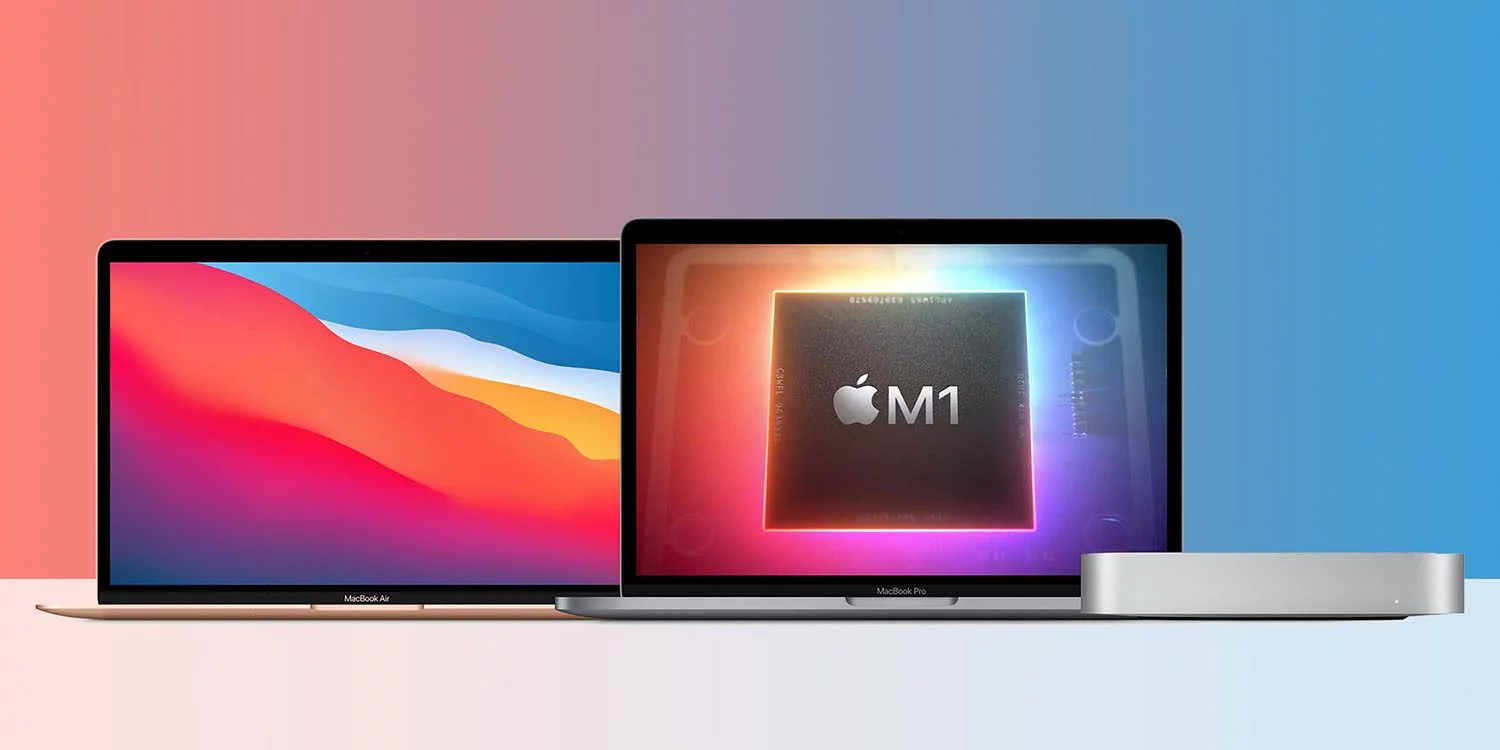

Comments (1)